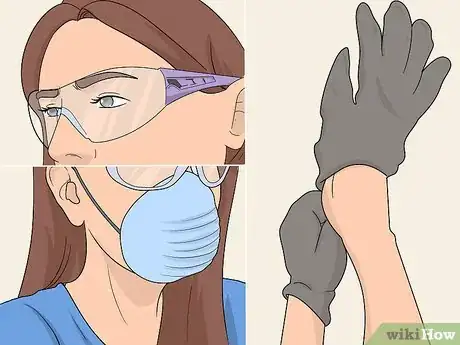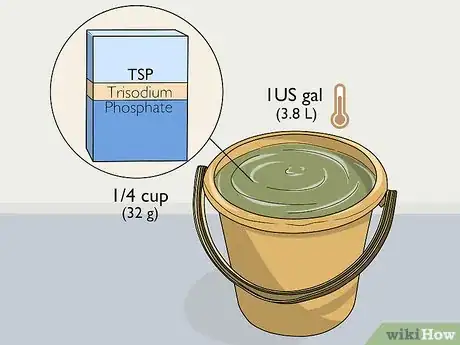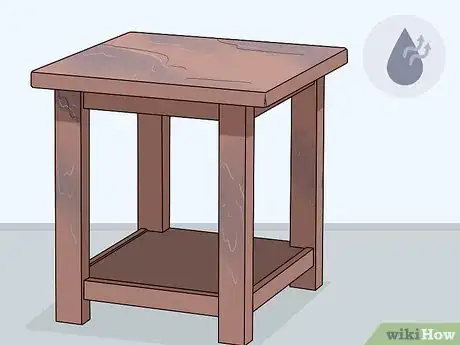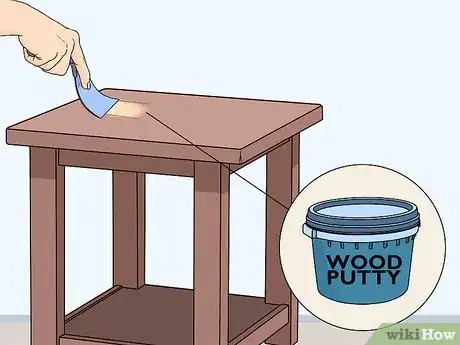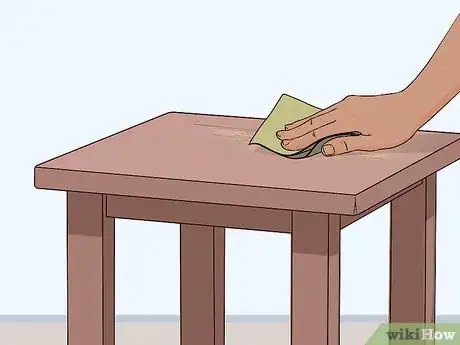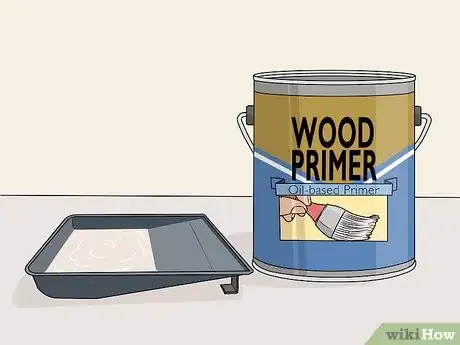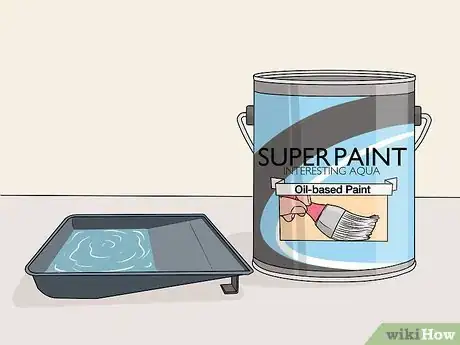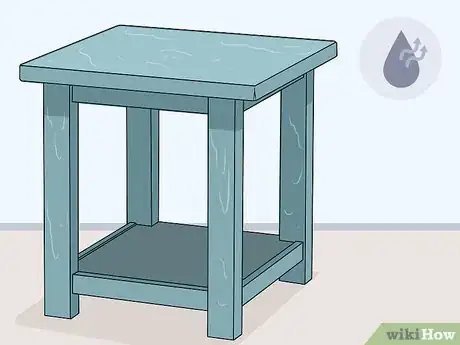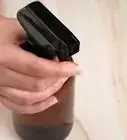This article was co-authored by Ez's Painting LLC. Ez's Painting LLC is a team of Painting Professionals based in Olympia, Washington. With more than twelve years of experience, the EZ's Painting team specializes in both commercial and residential painting projects. Ez's Painting LLC holds a contractor license in the state of Washington.
There are 14 references cited in this article, which can be found at the bottom of the page.
This article has been viewed 21,708 times.
A polyurethane finish or varnish is a durable coating that protects a wooden surface, which means you can’t paint directly over it or your paint won’t adhere to it. But with the right materials, and a little bit of elbow grease, you can paint over the polyurethane. Start by cleaning the surface and filling in any cracks or imperfections. You can then sand off the finish to allow your primer and paint to adhere to the surface without peeling off. Once the surface is primed, apply as many layers of paint as it takes to achieve the look you want!
Things You Should Know
- You can try painting directly over a polyurethane finish with any type of paint, but it’s very likely to start peeling off over time.[1]
- If you aren’t stripping the polyurethane, priming the surface and using an enamel paint is likely to going to give you the best results.
- If you don’t want to totally strip the polyurethane off, at least sand the surface with a sanding sponge or block to remove the sheen from the surface layer of the material.
- For the absolute best results, sand the surface thoroughly until you remove the polyurethane entirely, apply 3 layers of oil-based primer, and then paint the surface the same way you’d paint anything else.
Steps
Cleaning and Preparing the Surface
-
1Put on a pair of rubber gloves, safety glasses, and a facemask. Trisodium Phosphate, also known as TSP, is a powerful cleaning solution that will remove grease, dirt, and grime from the polyurethane surface, but it’s also toxic.[2] Before you begin working with it, put on a pair of rubber gloves and safety glasses to avoid exposure from splashes or spills, and wear a face mask to keep from inhaling the fumes.[3]
- Be sure to work in a well-ventilated area as well. Open up windows and use fans to increase circulation if you’re working indoors.
-
2Combine 1/4 cup (32 g) of TSP with 1 gallon (3.8 L) of water in a bucket. Use a medium-sized bucket and fill it with the water first. Then, measure out the TSP and slowly pour it into the water. Use a stir stick or wooden spoon to stir the mixture so it’s fully combined.[4]
- Be careful not to splash the mixture when you stir it.
- Use a clean bucket to keep from adding additional dirt to the surface.
Alternative: For a gentler cleaning solution, fill a bucket with 1 gallon (3.8 L) of warm water and add about 1 tablespoon (15 mL) of dish soap. Stir the mixture well to combine it and create a soapy cleaning solution.
Advertisement -
3Scrub the polyurethane surface with a sponge. Take a sponge with a scrubbing surface, soak it into the cleaning solution, and then wring out the excess. Apply firm pressure and wipe the polyurethane surface in circular motions to remove any dirt, grime, dust, or any other residue that may be present.[5]
- The surface needs to be clean to keep the paint from collecting dust or clumping together when you apply it.
- For stubborn grime or stains on the polyurethane, spread the cleaning solution over the area with a sponge and then scrub in circular motions with a bristled scrubbing brush.
-
4Allow the surface to dry completely.[6] Wait at least 10 minutes and then check to see if the surface is dry by lightly touching it with your finger. If it still feels slightly damp, wait another 5 minutes before checking again.[7]
- It’s important that the surface is completely dry before you begin to sand and paint it.
- Use a clean, dry towel or cloth to wipe the surface and speed up the drying time.
-
5Fill in any cracks, chips, or holes with wood putty and let it dry. Wood putty is a paste used to fill breaks or uneven areas to create a smooth and uniform surface. Use a flexible putty knife to scoop out a small amount of putty and spread it over any cracks, holes, or imperfections on the surface. Read the packaging for specific drying times and allow the putty to dry completely.[8]
- Apply just enough putty to form an even layer.
- Fill any imperfections that you see on the surface.
- You can find wood putty at hardware stores, home improvement stores, and online.
Sanding the Surface
-
1Wear a face mask to avoid inhaling any dust. Sanding the polyurethane will create flakes and dust that can irritate your throat and lungs if you inhale them. To be on the safe side, put on a face mask before you start sanding.[9]
- Look for protective face masks at hardware stores, department stores, and online.
- You could also tie a bandana around your face to cover your mouth and nose.
-
2Scrub the polyurethane surface with fine-grit sandpaper.[10] Use sandpaper between the range of 120 to 220-grit to sand the polyurethane surface. Use small, circular motions and work in sections to scrape the entire surface and scuff up the polyurethane coating. You don’t need to remove all of the polyurethane, but it needs to be scuffed so your primer and paint will stick to it.[11]
- For larger surfaces use an automatic sander to cut down on time.
Tip: If you’d like an even smoother surface, switch to a 60 or 80-grit sandpaper after you finish with the fine-grit sandpaper and sand it down even further.
-
3Vacuum all of the dust from the surface and surrounding area. Use a shop vac or the hose of a standard vacuum cleaner to suck up the dust directly from the surface you sanded. Vacuum up the dust from the floor or surrounding area as well.[12]
- A small, handheld vacuum cleaner is a great option to suck up the dust from the surface.
-
4Wipe down the surface with a clean, damp rag. Soak a clean rag in clean water and wring out the excess. Run the rag over the entire polyurethane surface to pick up any additional dust that may have been left behind.[13]
- You could also use a clean damp sponge or damp paper towels to wipe the surface clean.
Priming and Painting the Surface
-
1Use a foam roller for large surfaces and a bristled paintbrush for smaller ones. A paint roller will allow you to cover more surface area when you apply your primer and paint, making it the best choice for larger surfaces such as tables, walls, and doors. Smaller, more detailed surfaces such as baseboards, antique dressers, or the smaller edges of a door or table are better suited for a 1–2 in (2.5–5.1 cm) paintbrush.[14]
- Many paint jobs will call for both a roller and a brush. Use the roller for broad surfaces and the brush for smaller surfaces such as edges and trim.
-
2Pour oil-based primer into a paint tray. Choose a white, oil-based primer for the best coverage and adhesion to the polyurethane surface.[15] Open the can of primer and stir it well with a paint stirrer to break up any solids and combine it. Then, slowly pour the primer into the reservoir of a clean paint tray.[16]
- Don’t overfill the reservoir. You’ll need the textured ridges of the paint tray to scrape off the excess.
-
3Dip your brush or roller into the primer, apply a thin coat, and let it dry. Insert your roller or brush into the primer in the reservoir and wipe off the excess over the textured ridges of the tray to prevent drips. Use smooth up and down motions to roll or brush the paint onto the polyurethane surface. Apply a thin and even layer of the primer to the entire surface, and then let the coating dry completely..[17]
- Check the can for specific drying times and check that the first coat of primer is dry by touching it with your finger.
Primer Tip: If you’re covering dark wood or a dark-colored polyurethane, apply a second layer of primer after the first layer fully dries.
-
4Add an oil-based paint into a clean paint tray. Oil-based paints will adhere to the primer and polyurethane surface best and will last longer than water-based paints. Open your can of paint and use a paint stirrer to stir it well. Then, slowly pour the paint into the reservoir of a clean paint tray.[18]
- Make the tray is clean and doesn’t contain any of the primer, which will dilute the paint and affect its adhesion as well as it’s appearance and color.
- Visit a local paint supply store or home improvement store, or go online to choose your oil-based paint.
-
5Apply a thin layer of paint with your roller or paintbrush. Roll your roller or dip your brush into the paint in the tray and wipe off the excess on the textured ridges of the tray. Work in sections and spread the paint onto the polyurethane surface using up and down strokes. Use smooth, consistent motions to apply a thin, even layer of paint over the entire surface.[19]
- If you can still see through the first layer, don’t worry! You’ll need to apply at least 2 coats of your paint for effective coverage.
-
6Allow the paint to dry and add another 1-2 coats.[20] Wait at least half an hour to allow the coat of paint to dry and then check it with your finger. Add another layer of paint and then allow it to dry. If you can still see the primer and polyurethane through the coats of paint, add another layer for more coverage.[21]
- Check the can of paint for specific drying times.
- Make sure the paint is completely dry between coats or they won’t adhere properly and won’t form a smooth and uniform surface.
Things You’ll Need
- Rubber gloves, safety glasses, and a face mask
- Trisodium Phosphate (TSP)
- Medium bucket
- Scrubbing sponge
- Wood putty (if necessary)
- 120 to 220-grit sandpaper
- Paint roller or brush
- Oil-based primer
- Oil-based paint
- Paint tray
References
- ↑ Ez's Painting LLC. Painting Professionals. Expert Interview. 12 January 2022.
- ↑ Ez's Painting LLC. Painting Professionals. Expert Interview. 12 January 2022.
- ↑ https://www.bobvila.com/articles/cleaning-with-tsp-trisodium-phosphate/
- ↑ https://www.house-painting-info.com/articles/trisodium-phosphate/#.XgplD0dKgdU
- ↑ https://www.aconcordcarpenter.com/painting-over-polyurethane.html/3
- ↑ Ez's Painting LLC. Painting Professionals. Expert Interview. 12 January 2022.
- ↑ https://youtu.be/8YEML20wk0E?t=47
- ↑ https://youtu.be/8YEML20wk0E?t=47
- ↑ https://youtu.be/8YEML20wk0E?t=76
- ↑ Ez's Painting LLC. Painting Professionals. Expert Interview. 12 January 2022.
- ↑ https://www.bobvila.com/articles/2145-quick-tip-choosing-sandpaper/
- ↑ https://www.aconcordcarpenter.com/painting-over-polyurethane.html/4
- ↑ https://youtu.be/8YEML20wk0E?t=83
- ↑ https://youtu.be/8YEML20wk0E?t=142
- ↑ Ez's Painting LLC. Painting Professionals. Expert Interview. 12 January 2022.
- ↑ https://www.aconcordcarpenter.com/painting-over-polyurethane.html/5
- ↑ https://youtu.be/8YEML20wk0E?t=102
- ↑ https://www.bobvila.com/articles/493-the-basics-of-paint-selection/
- ↑ https://youtu.be/8YEML20wk0E?t=152
- ↑ Ez's Painting LLC. Painting Professionals. Expert Interview. 12 January 2022.
- ↑ https://youtu.be/8YEML20wk0E?t=152

